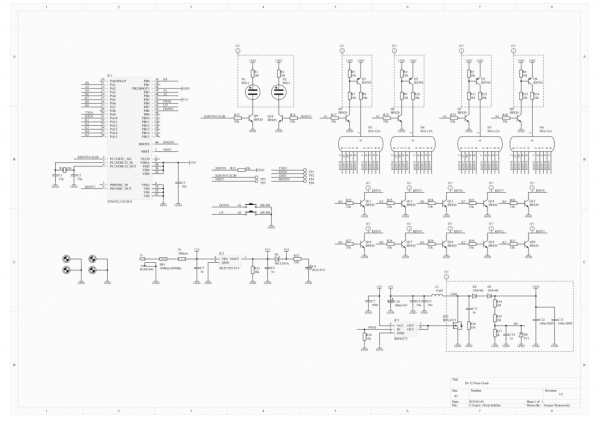Summary of IN-12 Nixie Clock
The article describes the creation of a minimalist, open-source Nixie tube clock using mid-20th-century neon numerical displays. The design features a single-board layout that incorporates IN-12 Nixie tubes for the HH:MM display and INS-1 neon lamps as colon separators, avoiding LEDs to maintain the authentic vintage look. The clock includes cleverly integrated micro-switch buttons beneath the colon lamps for time setting. The project emphasizes affordability, ease of manufacturing, and aesthetic preservation while compensating for quality variations in Soviet-made Nixie tubes.
Parts used in the IN-12 Nixie Clock:
- IN-12 Nixie tubes (4 pieces for HH:MM display)
- INS-1 Neon lamps (2 pieces for colon separator)
- Micro-switch buttons (2 pieces for time setting)
- Single PCB containing microcontroller, power supply, HV DC/DC converter, and Nixie drivers
A time has come for me to say ‘hello’ to the mid-XX century technology of Neon numerical displays, also known as Nixie tubes. Despite being quite hard to obtain and utilize I’ve decided to make a nice looking clock which (hopefully) would make a perfect Christmas present, and since the Christmas is all about sharing I thought It would be nice to go Open Source about it.
After few weeks of work I’ve ended up with neat single board design that makes the whole thing cheaper and easier to manufacture than the usual double board solutions (separate board for nixie lamps/divers, and another for microcontroller, power supply, high voltage dc/dc conversion, etc.). All of the circuitry is laid out on the back of the clock so it does not interfere with the old-school look of the Nixie displays.
Not a single LED was involved in that project, as I find those to be a disgrace when mixed up with neon indicators. (Geez, this is like, ‘your opinion’, man! )
The ‘Ne’ part
I wanted to keep the clock’s form factor as small as possible, so I chose it to be a standard HH:MM clock (without ‘seconds’ display) which requires only four Nixie tubes and two neon lamps for the separating colon.
I’ve decided to use IN-12 type Nixies as those are very popular here in Eastern Europe, but can also be easily bought on ebay and shipped worldwide. Those lamps are actually pretty cheap, mostly because they were manufactured in really large quantities back in the day. One thing that’s worth mentioning: since those Nixies come straight from Soviet Union, where almost no one paid any attention to the quality of whatever they’ve been producing, it will be wise to buy, let’s say a 150% of lamps that you need for your project. This gives the possibility to compensate for all imperfections (and believe me, these can get ugly like: digits being tilted, pins not being centered, ‘funny’ frontal grid color, etc.) which can easily degrade the overall look of your Nixie clock.
As for the separating colon I went for INS-1 Neon lamp, which has the advantage of being similar in height as the glassy part of IN-12, so it will make a perfect separator.
Every clock needs a way of setting the time, and the simplest way of achieving this is to embed buttons (like micro-switches). Since I’m aiming towards keeping the overall look to be as minimalistic as it is possible (well, Nixies don’t necessarily present themselves as ‘minimalistic’ to begin with.. ) I came up with a neat idea of placing the two buttons just under the INS-1 lamps, so when colon dots are pushed they, in fact, press the micro switches and, since the switches have the ‘springy’ action they move the colon lamps back to their original position as soon as user stops pushing.
For more detail: IN-12 Nixie Clock

